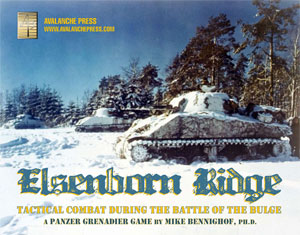| The
U.S. Army at Elsenborn Ridge
By Mike Bennighof, PhD
May 2020
 One of the unexpected aspects of researching and designing
games in the Panzer
Grenadier series is that it's relatively difficult
to find good, consistent tables of organization for the U.S.
Army in World War II. The German Army is described in loving
(and often disturbing) detail both in print and on the internet,
and similar though much less extensive resources exist for
the Japanese, British, Italian and even Polish forces. One of the unexpected aspects of researching and designing
games in the Panzer
Grenadier series is that it's relatively difficult
to find good, consistent tables of organization for the U.S.
Army in World War II. The German Army is described in loving
(and often disturbing) detail both in print and on the internet,
and similar though much less extensive resources exist for
the Japanese, British, Italian and even Polish forces.
Yet it was the U.S. Army that held and threw back the German
assault in the Ardennes at the tail end of 1944. While American
soldiers went into battle with more material support and better
food and sanitation than any army in history, at the sharp
end of things combat still boiled down to the struggle of
armed men at close quarters, and it was the American soldier
who vanquished the Nazi hordes.
Today we'll
have a glance at American forces present in Elsenborn Ridge that aren't found
in other Panzer Grenadier games.
On Tracks and Wheels

Some years ago I took a few months away from my dissertation
(because everyone delays finishing their dissertation) to
do a re-write on a friend's memoirs of his Second World War
service with the Third Armored Division. Belton Cooper had
very little good to say about the quality of American tanks,
in which he watched many brave men die for what he believed
to be the War Department's blundering.

Early Panzer Grenadier games included only two versions of the
M4 Sherman: the standard M4 with the low-velocity 75mm gun,
and the close-support version with a 105mm howitzer. The M4
is present here as well, plus the M4/105. But we added
the M4/76, by the end of 1944 the more common tank
in American battalions. It has a better anti-tank capability,
but is not quite as good against soft targets.

Heavy artillery rarely makes an appearance in Panzer Grenadier
series games with its own pieces, as it's factored into the
off-board artillery mechanism. But the Americans get an M12
here, a 155mm GPF rifle mounted on a tracked chassis. One
of these vehicles punished SS troops in La Gleize on 22 and
23 December, blasting them at point-blank range. Punishing
the SS is always a good thing, and so we really had to include
the piece in the game. The M16, a halftrack with four of the
awesome .50-claiber machine guns in a quad mount, has appeared
before but we did not have the unique drawing used for this
piece.
On Foot

At Lanzerath on the opening day of the German offensive,
a lone Intelligence and Reconnaissance (I&R) Platoon led
by Lt. Lyle Bouck faced an entire battalion of German paratroopers.
The Americans inflicted hundreds of casualties on the advancing
Germans, and the platoon became the most decorated small unit
of the war, with a Presidential Unit Citation, four Distinguished
Service Crosses and five Silver Stars - though all the survivors
were captured by the Germans, almost all of them wounded.
Yet we had never included this unit in a Panzer Grenadier
game before. One such platoon was attached to each infantry
regiment. Although the heroic battle at Lanzerath doesn't
make for much of a scenario - no German player is going to
deploy his or her forces as idiotically as did their historical
counterpart - there are a handful of other situations where
they do appear and their special abilities needed to be modeled.
On Wings

The P47 Thunderbolt was
a good fighter plane, but absolutely devastating in the ground-attack
role. And when the weather is clear, the American player will
often have copious air units available.
Though the P47 made the most notable impact on German consciousness,
many other types flew ground-support missions as well. The
attack squadrons with their A26 and B25 light and medium bombers
were very effective as well.
When American air units arrive, they usually do so in much
greater numbers than have been seen in previous games in the
series. And they have greater attack factors than those of
other nationalities as well. Like an actual German commander,
German players will have to watch the skies constantly.
Don't miss out on all the action.
Order
Elsenborn Ridge TODAY!
Sign up for our newsletter right here. Your info will never be sold or transferred; we'll just use it to update you on new games and new offers.
Mike Bennighof is president of Avalanche Press and holds a doctorate in history from Emory University. A Fulbright Scholar and NASA Journalist in Space finalist, he has published over 100 books, games and articles on historical subjects.
He lives in Birmingham, Alabama with his wife, three children and his dog, Leopold.
|
